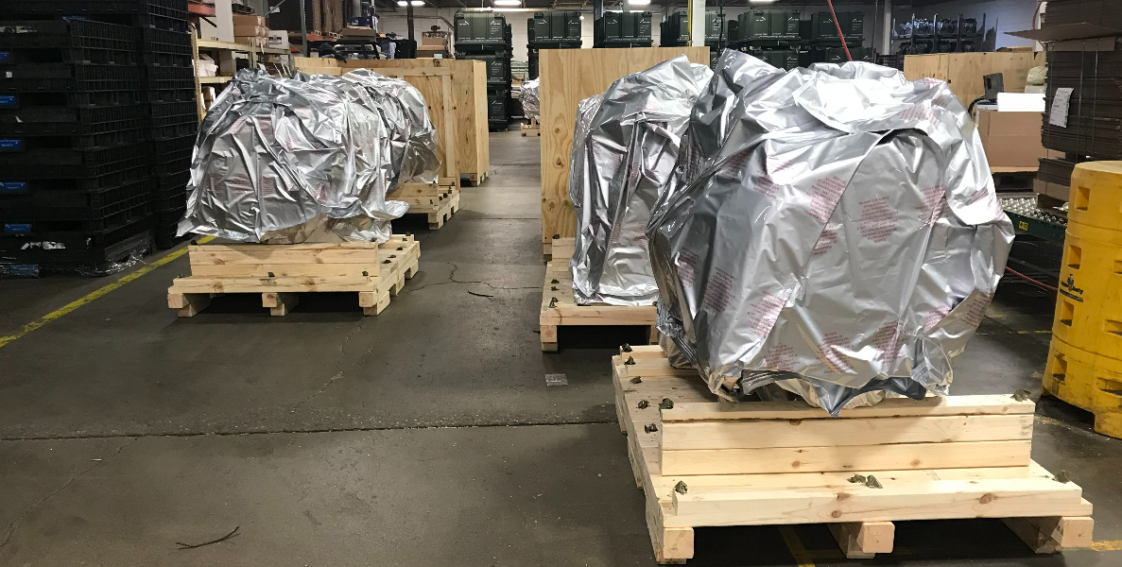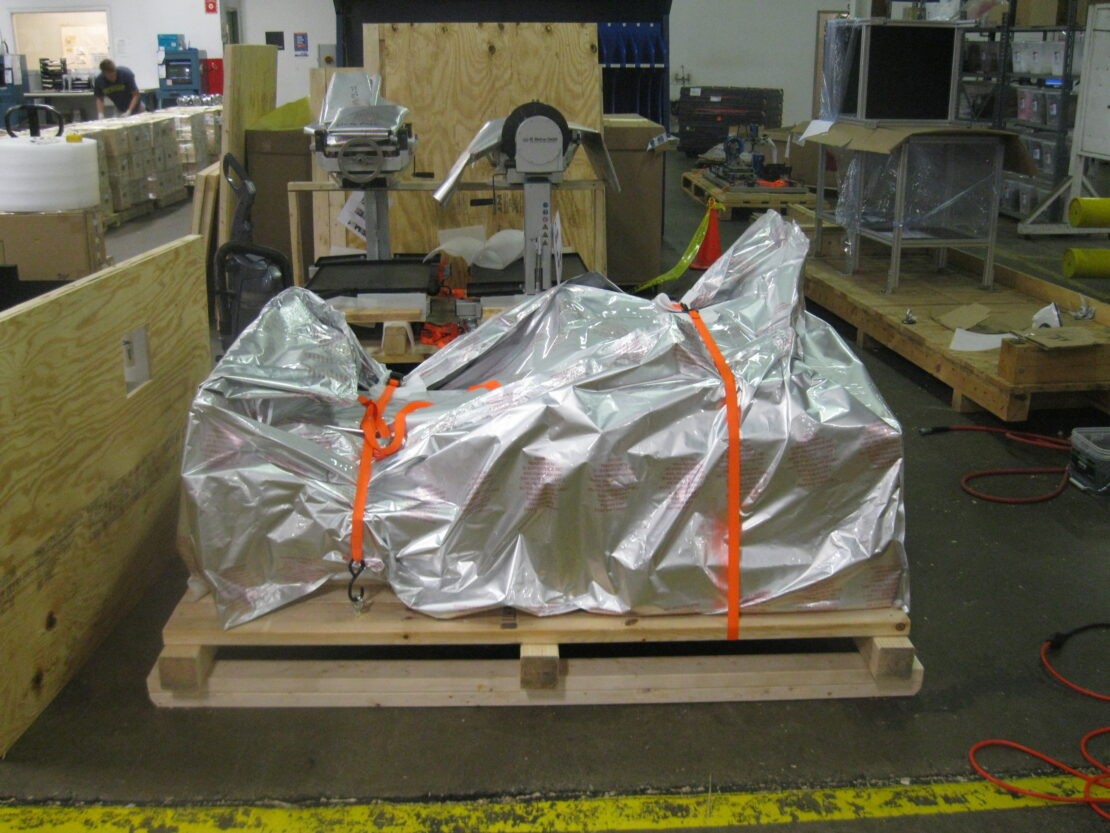
An Overview of the Crating and Packaging Process for Military Assets
When crating and packaging military assets, the stakes are often high. Military equipment, ranging from sensitive electronic systems to heavy-duty machinery, demands a packaging solution that goes beyond the standard. These aren’t just items—they’re integral to national security and often operate under the most demanding conditions imaginable.
Each component, whether it’s a high-precision instrument or a rugged vehicle part, comes with its unique set of requirements, which could include robust protection against physical shocks, environmental hazards, and potential security threats.
Designing and building proper packaging ensures that these critical assets are preserved and protected during every stage of transportation.
In this article, we’ll provide an overview of specific requirements for military packaging, standards and regulations, and unique challenges that come up when packaging these critical items.
Specific Requirements for Military Packaging

- Durability & Strength: Packaging must be able to withstand extreme conditions, including rough handling, heavy loads, and long-term storage. Materials used should be resilient to tears, punctures, and physical damage.
- Environmental Protection: Packaging should be capable of shielding contents from environmental elements, including moisture, dust, extreme temperatures, and UV radiation. Additionally, corrosion-resistant materials and moisture barrier protection are necessary for sensitive components.
- Security & Tamper Evidence: Packaging must have secure locking mechanisms to prevent unauthorized access. Tamper-evident features are needed to indicate if the package has been opened or compromised.
- Compatibility With Military Standards: All packaging must adhere to specific military standards and specifications for packaging, packing, and preservation.
- Ease of Handling & Transportation: The packaging must also be designed for efficient loading, unloading, and transport, including size and weight restrictions. Features like handles, forklift access points, and stackability are ideal.
- Regulatory Compliance: Packaging must also comply with international and domestic shipping regulations, including hazardous material regulations, if applicable.
Standards & Regulations in Military Packaging
There are five general standards and regulations governing military packaging. These include:
MIL-STD-2073 (Standard Practice)
This key standard outlines detailed requirements for preservation methods and packing levels, materials, and methods. It is a comprehensive guide for packaging military equipment, ensuring items are adequately protected against corrosion, physical and environmental damage, and other risks associated with military operations.
Understanding Codes
Under MIL-STD-2073, there are several key codes to know. Those are MOP, packaging level, container type, unit container size, and special marking.
MOP codes indicate preservation requirements. M1 indicates minimal protection/no sensitivity to environmental conditions, while M4 indicates that the packaging requires waterproof and greaseproof packaging.
Packing level codes are separated by A, B, or C. A means maximum protection is required against the most severe environmental, handling, and shipping conditions, while C means that minimal protection is needed.
The container code indicates what type of container should be used. For example, 1D means fiberboard box, 3H means plastic drum, and 4G means fiberboard box with inner receptacles.
The unit container size codes are marked ‘A,’ ‘B,’ ‘C,’ etc. Each letter corresponds to a range of dimensions and/or capacities defined in MIL-STD-2073.
Finally, special marking codes indicate specific handling, safety, or environmental requirements. Anything marked ‘H’ means hazardous, while ‘F’ means that items must be in a specific orientation during transport.
MIL-STD-129R (Military Marking for Shipment & Storage)
This standard specifies the marking requirements for military shipments and storage. It includes guidelines on how to label packages with critical information, such as the National Stock Number (NSN), part numbers, quantity, and handling instructions.
ASTM International Standards
Various ASTM standards apply to military packaging. The different standards focus on material specifications, testing methods, and performance criteria, ensuring that the materials and processes used in military packaging meet high-quality benchmarks. The primary ASTM standards that apply to military packaging include, but are not limited to:
- ASTM D3951, the standard practice for commercial packaging
- ASTM D4169, the standard practice for performance testing of shipping containers and systems
- ASTM D6251/D6251M, the standard specification for wood-cleated panelboard shipping boxes
- ASTM D4727/ASTM D4727M, the standard specification for corrugated and solid fiberboard sheet stock (container grade) and cut shapes
- ASTM D5118/ASTM D5118M, the standard practice for fabrication of fiberboard shipping boxes
- ASTM D5276, the standard test method for drop test of loaded containers by free fall
- ASTM D5487, the standard test method for simulated drop of loaded containers by shock machines
- ASTM D999, the standard test methods for vibration testing of shipping containers
International Traffic in Arms Regulations (ITAR) & Export Administration Regulations (EAR)
These regulations govern the export and import of defense-related articles and services. Compliance with ITAR and EAR is crucial for ensuring that sensitive military equipment is protected and handled in accordance with international laws.
Hazardous Material Regulations
For military equipment classified as hazardous, such as chemicals, batteries, or explosives, specific regulations dictate how these materials should be packaged, labeled, and transported. Hazardous material regulations are governed by multiple bodies, including:
- The Department of Transportation (DoT): DoT provides standards on how hazardous materials are packaged, labeled, and transported via road, rail, air, or sea.
- Environmental Protection Agency (EPA): The EPA provides regulations on handling and disposing of hazardous materials to reduce environmental impact.
- Occupational Safety & Health Administration (OSHA): OSHA provides guidelines on safely handling and storing hazardous materials in the workplace.
- Defense Logistics Agency (DLA): The DLA provides specific guidelines and support for the logistics of hazardous materials, including packaging, transportation, and storage.
- Military Departments & Defense Agencies: Individual branches of the U.S. military and various defense agencies have specific regulations and protocols for handling hazardous materials, which comply with broader federal regulations but are tailored to their unique operational needs.
- International Regulations: For the international transport of military hazardous materials, regulations such as the International Air Transport Association (IATA) Dangerous Goods Regulations and the International Maritime Dangerous Goods (IMDG) Code may apply.
Challenges & Strategies in Military Asset Logistics
Packaging and transporting military assets involves navigating many complex logistical challenges, often stemming from the unique nature of military equipment.
Primary Challenges
1. Handling Sensitive & High-Value Equipment
Military assets often include sensitive, high-value equipment that requires specialized handling to prevent damage or compromise. The best way to overcome this challenge is to use custom-designed packaging that caters to the specific needs of each piece of equipment.
2. Ensuring Security & Confidentiality
Ensuring the security of equipment and maintaining confidentiality during transit is crucial, given the sensitive nature of many military assets. To ensure security, you’ll need to work with a packaging provider to implement tamper-evident seals. Additional strategies include implementing GPS tracking and creating confidential handling protocols.
3. Maintaining Stability in Diverse Environmental Conditions
Military assets must be transported across a wide range of environments, from extreme heat and cold to humid or salt-laden atmospheres. To overcome this, you must conduct rigorous testing and run simulations that mimic various environmental conditions.
4. Maintaining Compliance With Regulations
As you’ve likely noticed, there are a lot of regulations governing military assets. Continuous education and training can help ensure compliance and minimize the risk of errors. Additionally, working with a third-party provider specializing in military packaging can help ensure compliance.
Get Help With Military Packaging
Get robust military packaging solutions from Export Corporation. We’ve specialized in custom military packaging and preservation for over seven decades and can help you stay compliant with mil-spec requirements, including ASTM D3951, MIL-STD-129R, and MIL-STD-2073. In addition to our experience, we hold several certifications and registrations, including ISO 9001, ISPM-15, ITAR, and SAM.
Please visit our website to view some of our past projects, or contact us today to request a consultation.
